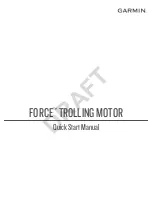
QUICK START GUIDE FOR DEMONSTRATION CIRCUIT 875
HIGH EFFICIENCY BUCK-BOOST FLASH LED DRIVER
1
LTC3454EDD
DESCRIPTION
Demonstration circuit 875 is a high efficiency buck-
boost flash LED driver featuring the LTC3454EDD. The
board has two circuits optimized for different applica-
tions: a small footprint solution featuring 350mA,
300ms LED flash current or 150mA constant LED
torch current, and a high current solution featuring
400 / 600 / 1000mA constant-current operation. The
input voltage range of 2.7V to 5.5V is suitable for a
single Lithium-Ion battery or three AAA batteries in
series. The Li-Ion input range, high LED flash current
with separate torch mode current setting, internal
synchronous power switches, minimal and low-
profile external components, and simple design
makes the LTC3454 the top solution for highly effi-
cient, space-constrained cellular telephone camera
flash solutions.
The high current solution is activated by depressing
momentary switches ‘EN1’ and ‘EN2’ in accordance
with the table provided on the silkscreen, or connect-
ing the corresponding terminals to ‘VIN’ with a
jumper wire. The small footprint solution is turned on
and off by pressing the ‘ON/OFF’ button. A ‘TORCH’
button turns the LED on at 150mA for cellular tele-
phone video recording. The ‘FLASH’ button flashes
the LED at 350mA for 300ms for cellular telephone
camera flash operation. The buttons control the state
of the PIC microcontroller IC that is programmed with
DC875 software. The PIC keeps the LED from being
flashed constantly, preventing overheating and burn-
out. The PIC also controls the flash time. When no
buttons are pressed for a short time, the PIC turns off
and the circuit enters low-power mode for battery-life
preservation. A red/green LED indicates the state of
the PIC. The LED is ready to flash or torch if the state
indicator is blipping green. If the indicator is not on,
the PIC is turned off. For a brief time after the flash
has occurred, the state-indicator LED is red, indicat-
ing that another flash cannot happen, even if the but-
ton is pressed, until the red LED is off and the green
LED is blipping again. Alternatively, the torch and
flash modes can be enabled by connecting ‘EN1’
(torch), or’ EN1’ and ‘EN2’ (flash) to ‘VIN’, as indi-
cated in the table.
WARNING- Do not pull down the ‘ENx’ pins on the
small current solution while the PIC is active, as dam-
age to the PIC outputs may result.
WARNING- The small footprint solution LED can be
permanently damaged if the flash mode is engaged for
more than a few seconds.
The PIC control circuit may be used to control the
high current solution circuit by connecting the ‘EN1’
and ‘EN2’ pins of each solution in parallel, and apply-
ing power to both circuits. Typical efficiency for the
demo circuits is presented in Figure 2. Higher effi-
ciency can be obtained by selecting larger inductors
with lower ESR.
The LTC3454 datasheet gives a complete description
of the part, operation and applications information.
The datasheet must be read in conjunction with this
Quick Start Guide for demonstration circuit 875. In
addition, the Lumileds Luxeon III Star datasheet
(
www.lumileds.com
) and the AOT2015 datasheet
(
www.aot.com
) must be read to understand thermal
and LED current constraints for varying flash current
pulse-widths and intensity. The LTC3454 is assem-
bled in a small low profile DFN package. Proper board
layout is essential for maximum thermal perform-
ance. See the datasheet section ‘Layout Considera-
tions’.
Design files for this circuit board are available. Call
the LTC factory.
LTC is a trademark of Linear Technology Corporation
Downloaded from
























